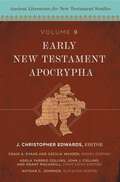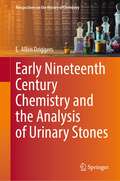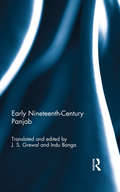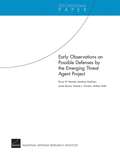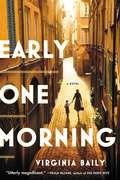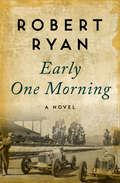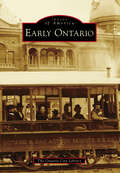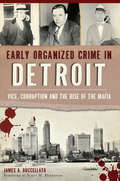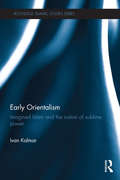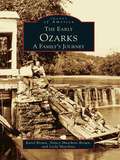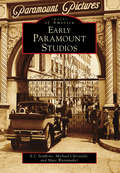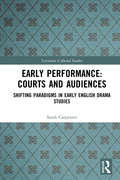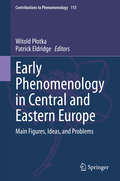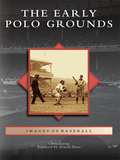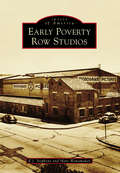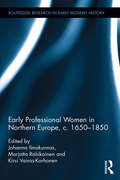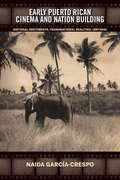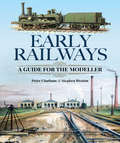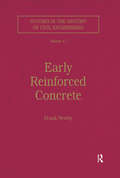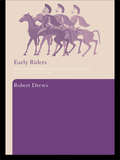- Table View
- List View
Early New Testament Apocrypha (Ancient Literature for New Testament Studies)
by ZondervanBroaden the scope of your New Testament studies with this introduction to early Christian apocryphal literature.To understand the New Testament well, it is important to study the larger world surrounding it, and one of the primary avenues for this exploration is through reading related ancient texts. But this task is daunting for scholars and novices alike given the sheer size of the ancient literary corpora. The Ancient Literature for New Testament Studies series aims to bridge this gap by introducing the key ancient texts that form the cultural, historical, and literary context for the study of the New Testament.Early New Testament Apocrypha offers an entry point into the corpus of early Christian apocryphal literature through twenty-eight texts or groups of texts. While the majority of the texts fall within the first four centuries CE, and therefore are useful for uncovering the earliest interpretations assigned to the New Testament, select later texts serve as reminders of how the meanings of New Testament texts continued to develop in subsequent centuries. Each essay covers introductory matters, a summary of content, interpretive issues, key passages for New Testament studies and their significance, and a select bibliography.Whether you are a scholar looking to familiarize yourself with a new corpus of texts or a novice seeking to undertake a serious contextualized study of the New Testament, this is an ideal reference work for you.Essays and contributors include:Part 1: Apocryphal GospelsAgrapha, Andrew GregoryFragments of Gospels on Papyrus, Tobias NicklasGospel of Barnabas, Philip JenkinsGospel of Peter, Paul FosterInfancy Gospel of Thomas, Reidar AasgaardJewish-Christian Gospels, Petri LuomanenLegend of Aphroditian, Katharina HeydenPilate Cycle, J. K. ElliottProtevangelium of James, Eric M. Vanden EykelToledot Yeshu, Sarit Kattan GribetzRevelation of the Magi, Catherine PlayoustPart 2: Apocryphal ActsActs of Andrew, Nathan C. JohnsonActs of John, Harold W. AttridgeActs of Paul, Harold W. AttridgeActs of Peter, Robert F. Stoops, Jr.Acts of Philip, Christopher R. MatthewsActs of Thomas, Harold W. AttridgeDeparture of My Lady Mary from This World (Six Books Dormition Apocryphon), J. Christopher EdwardsPseudo-Clementines, F. Stanley JonesPart 3: Apocryphal EpistlesJesus's Letter to Abgar, William AdlerCorrespondence of Paul and Seneca, Andrew GregoryEpistle to the Laodiceans, Philip L. TiteEpistula Apostolorum, Florence GantenbeinThe Sunday Letter, Jon C. LaansmaPart 4: Apocryphal ApocalypsesApocalypse of Paul, Jan N. BremmerApocalypse of Peter (Greek), Dan BatoviciApocalypse of Thomas, Mary Julia Jett1 Apocryphal Apocalypse of John, Robyn J. WhitakerNew Testament Apocrypha: Introduction and Critique of a Modern Category, Dale B. MartinSERIES DESCRIPTION:Ancient Literature for New Testament Studies is a 10-volume series that introduces key ancient texts that form the cultural, historical, and literary context for the study of the New Testament.Each volume features introductory essays to the corpus, followed by articles on the relevant texts. Each article will address introductory matters, provenance, summary of content, interpretive issues, key passages for New Testament studies and their significance, and a select bibliography.Neither too technical to be used by students no
Early Nineteenth Century Chemistry and the Analysis of Urinary Stones (Perspectives on the History of Chemistry)
by E. Allen DriggersThis book tells the story of how chemists, physicians, and surgeons attempted to end the problem of urinary stones. From the late eighteenth to the early nineteenth centuries, chemists wanted to understand why the body formed urinary, pancreatic, and other bodily stones. Chemical analysis was an exciting new means of understanding these stones and researchers hoped of possibly preventing their formation entirely. Physicians and surgeons also hoped that, with improved chemical analysis, they would eventually identify substances that would reduce the size of stones, leading to their easier removal from the body. Urinary stones and other stones of the body caused the boundaries of surgery, chemistry, and medicine to blur. The problem of the stone was transformational and spurred collaboration between chemistry and medicine. Some radical physicians in America and Britain combined this nascent medical advancement with older disciplines, like humoral theory. Chemists, surgeons, and physicians in Charleston, Philadelphia, and London focused on the stones of the body. Chemical societies and museums also involved themselves in the problem of the stone. Meanwhile, institutions in Charleston, Philadelphia, and London served as repositories of specimens for testing and study as previously disparate practitioners and disciplines worked toward the comprehensive knowledge that could, perhaps, end suffering from stones. The primary audience of this book is historically-minded chemists, surgeons, physicians, and museum professionals.
Early Nineteenth-Century Panjab
by J. S. Grewal Indu BangaThe Chār Bāgh-i-Panjāb, written by Ganesh Das Wadera immediately after the annexation of the Lahore kingdom by the British in 1849, is a classic Persian text. Its long descriptive part is the only surviving account of the social, religious, and cultural life of the peoples of the Punjab, especially during the late-eighteenth and the early-nineteenth century. Ganesh Das writes about traditional learning, literature, folklore, urban centres, and women with a rare catholicity as an Indian, an orthodox Hindu, a Punjabi, and a Khatri. Himself a hereditary qanungo of Gujrat in the Sikh kingdom, he also provides valuable insights into the structure of revenue administration at lower rungs. This volume presents an authoritative English translation of this primary descriptive section of Chār Bāgh-i-Panjāb, with a detailed Introduction, critical commentary, glossary, map, and a classified index. Indispensable for researchers, it will interest historians of medieval and modern India, especially those concerned with the pre-Independence Punjab region.
Early Observations on Possible Defenses by the Emerging Threat Agent Project
by Bruce W. Bennett Pamela L. Gordon Mcrae Smith Jonathan Kaufman James ByrnesAdversaries could acquire emerging chemical and biological (CB) agents years before U.S. defense planners recognize those agents, and many more years before the United States establishes a comprehensive defense against them. Gaps in defenses against chemical and biological weapon agents can pose a serious risk to U.S. military operations. This paper summarizes early expert observations about the threat and possible responses.
Early One Morning
by Virginia BailyTwo women's decision to save a child during WWII will have powerful reverberations over the years.Chiara Ravello is about to flee occupied Rome when she locks eyes with a woman being herded on to a truck with her family.Claiming the woman's son, Daniele, as her own nephew, Chiara demands his return; only as the trucks depart does she realize what she has done. She is twenty-seven, with a sister who needs her constant care, a hazardous journey ahead, and now a child in her charge.Several decades later, Chiara lives alone in Rome, a self-contained woman working as a translator. Always in the background is the shadow of Daniele, whose absence and the havoc he wrought on Chiara's world haunt her. Then she receives a phone call from a teenager claiming to be his daughter, and Chiara knows it is time to face up to the past.
Early One Morning: A Novel (The Secret War Trilogy #1)
by Robert RyanA &“damn near irresistible&” novel of friendship, fast cars, and spying for the Resistance in occupied France—based on a true story (Time Out London). On a crisp autumn night in the twenty-first century, a car is pulled from the depths of an Austrian lake. A skeleton grips the wheel. Finally, an answer: William Grover-Williams, the premier English race-car driver of his generation and a hero of the French Resistance, met his end at the bottom of a mountain lake. Or did he? In the Roaring Twenties, Grover-Williams and Frenchman Robert Benoist were teammates and rivals on the Bugatti racing team. Locked in a fierce competition for the world championship, they also raced to win the heart of the gorgeous Eve Aubicq. Then the war changed everything—and nothing. As members of the British Special Operations Executive, Grover-Williams and Benoist dashed across France in support of the Resistance, but it wasn&’t just the Nazis they had to watch out for. Double agents were everywhere, and friendship—or love, for that matter—was no guarantee of loyalty. Every morning, Will, Robert, and Eve had to look in the mirror and ask: Whom can I trust today? The wrong answer might just have spelled their doom. Early One Morning is the 1st book in the Secret War Trilogy, which also includes Blue Noon and Night Crossing.
Early Ontario
by The Ontario City LibraryGeorge and William Chaffey, immigrants from Canada, founded a model colony in Southern California in 1882. They named their settlement Ontario, from an Iroquois term meaning beautiful water, not only to pay homage to their home province but to also draw other Canadians to their colony. Utilizing forward-thinking irrigation practices, the brothers laid out plots of land ready for colonists who wanted to farm or raise citrus groves. After just four years, the brothers left for Australia to develop more settlements and passed their model colony on to Charles Frankish and his partners of the Ontario Land and Improvement Company. From its earliest days, the colony became known for its citrus groves, Armstrong roses, Graber olives, Guasti grapes, and the Hotpoint iron. This book, which includes nearly 200 images, focuses on the colony's early development.
Early Organized Crime in Detroit: Vice, Corruption and the Rise of the Mafia (True Crime)
by James BuccellatoThough detectives denied it, the Italian mafia was operating in Detroit as early as 1900, and the city was forever changed. Bootleggers controlled the Detroit River and created a national distribution network for illegal booze during Prohibition. Gangsters, cops and even celebrities fell victim to the violence. Some politicians and prominent businessmen like Henry Ford's right-hand man, Harry Bennett, collaborated closely with the mafia, while others, such as popular radio host Gerald Buckley, fought back and lost their lives. Social scientist and crime writer James A. Buccellato explores Detroit's struggle with gang violence, public corruption and the politics of vice during the tumultuous first half of the twentieth century.
Early Orientalism: Imagined Islam and the Notion of Sublime Power (Routledge Islamic Studies Series)
by Ivan KalmarThe history of western notions about Islam is of obvious scholarly as well as popular interest today. This book investigates Christian images of the Muslim Middle East, focusing on the period from the Renaissance to the Enlightenment, when the nature of divine as well as human power was under particularly intense debate in the West. Ivan Kalmar explores how the controversial notion of submission to ultimate authority has in the western world been discussed with reference to Islam’s alleged recommendation to obey, unquestioningly, a merciless Allah in heaven and a despotic government on earth. He discusses how Abrahamic faiths – Christianity and Judaism as much as Islam – demand devotion to a sublime power, with the faith that this power loves and cares for us, a concept that brings with it the fear that, on the contrary, this power only toys with us for its own enjoyment. For such a power, Kalmar borrows Slavoj Zizek’s term "obscene father". He discusses how this describes exactly the western image of the Oriental despot - Allah in heaven, and the various sultans, emirs and ayatollahs on earth – and how these despotic personalities of imagined Muslim society function as a projection, from the West on to the Muslim Orient, of an existential anxiety about sublime power. Making accessible academic debates on the history of Christian perceptions of Islam and on Islam and the West, this book is an important addition to the existing literature in the areas of Islamic studies, religious history and philosophy.
Early Ozarks, The: A Family's Journey
by Nancy Mashino Brown Karol Brown Leola MashinoDomino Danzero's journey, which began in Italy in 1890, led him penniless to New York. The young immigrant came to the Midwest and found work in the coal mines of Illinois and the restaurants of Chicago. Through his travels and his work he gained employment with the Frisco railroad, where he became the overseer of Harvey Houses and Frisco dining cars throughout the central United States. Photography was his hobby and he was commissioned to take photographs for the Frisco railroad. The turn-of-the-century photographs featured in The Early Ozarks: A Family's Journey portray the humanness of people living in the Ozarks. They provide a glimpse of thebetter things in life--food, family, and friends--reflecting fundamental human compassion and the way of living at the early part of the twentieth century.
Early Paramount Studios
by Marc Wanamaker E. J. Stephens Michael ChristaldiFor over 100 years, Paramount Pictures has been captivating movie and television audiences worldwide with its alluring imagery and compelling stories. Arising from the collective genius of Adolph Zukor, Jesse L. Lasky, and Cecil B. DeMille during the 1910s, Paramount Pictures is home to such enduring classics as Wings, Sunset Boulevard, The Ten Commandments, Love Story, The Godfather, the Indiana Jones series, Chinatown, Forrest Gump, Braveheart, Titanic, and Star Trek. Early Paramount Studios chronicles Paramount's origins, culminating in the creation and expansion of the lot at 5555 Melrose Avenue, the last major motion picture studio still in Hollywood.
Early Performance: Shifting Paradigms in Early English Drama Studies (Variorum Collected Studies)
by Sarah CarpenterThese essays of Sarah Carpenter have been selected to reflect her career’s close focus on the relationship of performance and audience. They are drawn from the last 25 years of her writing, and this has enabled the editors to organise them not chronologically but rather to develop her central theme through a range of genres, including morality plays, the interlude, court entertainments, international political spectacle, and the public ‘performances’ of natural and maintained fools. As a scholar who also has experience of acting and of production, Carpenter is particularly sensitive to the implications of location for creating meaning and generating audience reaction. The essays are focused on a relatively short time-span of 120 years, from the late fifteenth to the turn of the seventeenth century, and thus nuance a period traditionally divided between the late medieval and the early-modern, and between Catholicism and Protestantism. Carpenter shows how the dynamics of theatrical engagement in which the roles of audience and performer are frequently mixed or even reversed offer a more creative route to understanding how the individual and society respond to change.
Early Phenomenology in Central and Eastern Europe: Main Figures, Ideas, and Problems (Contributions to Phenomenology #113)
by Patrick Eldridge Witold PłotkaThis book presents the origins of Central and Eastern European phenomenology. It features chapters that explore the movement's development, its most important thinkers, and its theoretical and historical context. This collection examines such topics as the realism-idealism controversy, the status of descriptive psychology, the question of the phenomenological method, and the problem of the world.The chapters span the first decades of the development of phenomenology in Czechoslovakia, Poland, Romania, Russia, and Yugoslavia before World War II. The contributors track the Brentanian heritage of the development. They show how this tradition inspired influential thinkers like Celms, Špet, Ingarden, Frank, Twardowski, Patočka, and others. The book also puts forward original investigations. Moreover it elaborates new accounts of the foundations of phenomenology. While the volume begins with the Brentanian heritage, it situates phenomenology in a dialogue with other important schools of thought of that time, including the Prague School and Lvov-Warsaw School of Logic.This collection highlights thinkers whose writings have had only a limited reception outside their home countries due to political and historical circumstances. It will help readers gain a better understanding of how the phenomenological movement developed beyond its start in Germany. Readers will also come to see how the phenomenological method resonated in different countries and led to new philosophical developments in ontology, epistemology, psychology, philosophy of culture, and philosophy of religion.
Early Polo Grounds, The (Images of Baseball)
by Chris Epting Arnold HanoThe Polo Grounds is one of baseball's most sacred ballparks. Built below Coogan's Bluff in 1891, the bathtub-shaped stadium played host to iconic baseball moments, including Willie Mays's famous catch in the 1954 World Series and Bobby Thomson's "shot heard 'round the world." The era before those moments holds a history all its own, when the New York Giants, Yankees, and the football Giants shared the park. The dawn of the 20th century through the 1920s is a rarely seen chapter in Polo Grounds history, and it is presented here for the first time in all of its photographic glory.
Early Postmodernism: Foundational Essays
by Paul A. BovéIn the decade that followed 1972, the journal boundary 2 consistently published many of the most distinguished and most influential statements of an emerging literary postmodernism. Recognizing postmodernism as a dominant force in culture, particularly in the literary and narrative imagination, the journal appeared when literary critical study in the United States was in a period of theory-induced ferment. The fundamental relations between postmodernism and poststructuralism were being initially examined and the effort to formulate a critical sense of the postmodern was underway. In this volume, Paul A. Bové, the current editor of boundary 2, has gathered many of those foundational essays and, as such, has assembled a basic text in the history of postmodernism.Essays by noted cultural and literary theorists join with Bové's contemporary preface to represent the important and unique moment in recent intellectual history when postmodernism was no longer seen primarily as an architectural term, had not yet come to describe the wide range of culture it does now, but was finding power and place in the literary realm. These essays show that the history of postmodernism and its attendant critical theories are both more complex and more deeply bound with literary criticism than often is acknowledged today. Early Postmodernism demonstrates not only the significance of these literary studies, but also the role played by literary critical postmodernism in making possible newer forms of critical and cultural studies.Contributors. Barry Alpert, Charles Altieri, David Antin, Harold Bloom, Paul A. Bové, Hélène Cixous, Gerald Gillespie, Ihab Hassan, Joseph N. Riddel, William, V. Spanos, Catharine R. Stimpson, Cornel West
Early Poverty Row Studios
by Marc Wanamaker E. J. StephensThe history of Hollywood is often seen only through the lens of the major studios, forgetting that many of Tinseltown's early creations came from micro-studios stretched along Sunset Boulevard in an area disparagingly known as Poverty Row. Here, the first wave of West Coast moviemakers migrated to the tiny village of Hollywood, where alcohol was illegal, actors were unwelcome, and cattle were herded down the unpaved streets. Most Poverty Row producers survived from film to film, their fortunes tied to the previous week's take from hundreds of nickelodeon tills. They would routinely script movies around an event or disaster, often creating scenarios using sets from more established productions, when the bosses weren't looking, of course. Poverty Row quickly became a generic term for other fly-by-night studios throughout the Los Angeles area. Their struggles to hang on in Hollywood were often more intriguing than the serialized cliffhangers they produced.
Early Professional Women in Northern Europe, c. 1650-1850
by Johanna Ilmakunnas Marjatta Rahikainen Kirsi Vainio-KorhonenThis book focuses on early examples of women who may be said to have anticipated, in one way or another, modern professional and/or career-oriented women. The contributors to the book discuss women who may at least in some respect be seen as professionally ambitious, unlike the great majority of working women in the past. In order to improve their positions or to find better business opportunities, the women discussed in this book invested in developing their qualifications and professional skills, took economic or other kinds of risks, or moved to other countries. Socially, they range from elite women to women of middle-class and lower middle-class origin. In terms of theory, the book brings fresh insights into issues that have been long discussed in the field of women’s history and are also debated today. However, despite its focus on women, the book is conceptually not so much focused on gender as it is on profession, business, career, qualifications, skills, and work. By applying such concepts to analyzing women’s endeavours, the book aims at challenging the conventional ideas about them.
Early Public Libraries and Colonial Citizenship in the British Southern Hemisphere (New Directions in Book History)
by Porscha Fermanis Sarah Comyn Lara Atkin Nathan GarveyThis open access Pivot book is a comparative study of six early colonial public libraries in nineteenth-century Australia, South Africa, and Southeast Asia. Drawing on networked conceptualisations of empire, transnational frameworks, and ‘new imperial history’ paradigms that privilege imbricated colonial and metropolitan ‘intercultures’, it looks at the neglected role of public libraries in shaping a programme of Anglophone civic education, scientific knowledge creation, and modernisation in the British southern hemisphere. The book’s six chapters analyse institutional models and precedents, reading publics and types, book holdings and catalogues, and regional scientific networks in order to demonstrate the significance of these libraries for the construction of colonial identity, citizenship, and national self-government as well as charting their influence in shaping perceptions of social class, gender, and race. Using primary source material from the recently completed ‘Book Catalogues of the Colonial Southern Hemisphere’ digital archive, the book argues that public libraries played a formative role in colonial public discourse, contributing to broader debates on imperial citizenship and nation-statehood across different geographic, cultural, and linguistic borders.
Early Puerto Rican Cinema and Nation Building: National Sentiments, Transnational Realities, 1897-1940 (Bucknell Studies in Latin American Literature and Theory)
by Naida García-CrespoEarly Puerto Rican Cinema and Nation Building focuses on the processes of Puerto Rican national identity formation as seen through the historical development of cinema on the island between 1897 and 1940. Anchoring her work in archival sources in film technology, economy, and education, Naida García-Crespo argues that Puerto Rico’s position as a stateless nation allows for a fresh understanding of national cinema based on perceptions of productive cultural contributions rather than on citizenship or state structures. This book aims to contribute to recently expanding discussions of cultural networks by analyzing how Puerto Rican cinema navigates the problems arising from the connection and/or disjunction between nation and state. The author argues that Puerto Rico’s position as a stateless nation puts pressure on traditional conceptions of national cinema, which tend to rely on assumptions of state support or a bounded nation-state. She also contends that the cultural and business practices associated with early cinema reveal that transnationalism is an integral part of national identities and their development. García-Crespo shows throughout this book that the development and circulation of cinema in Puerto Rico illustrate how the “national” is built from transnational connections. Published by Bucknell University Press. Distributed worldwide by Rutgers University Press.
Early Railways: A Guide for the Modeller
by Stephen Weston Peter ChathamHistory, references, and resources for modeling the earliest decades of British rail travel. This is a guide to the earliest period of railway history, from the very beginnings of steam traction at the start of the nineteenth century, up to about 1880. Over these few decades the railways evolved from something that at the start was markedly different, into a scene that any present-day railwayman would recognize. It is a time with much to commend it from a modeler&’s point of view. The trains were much shorter and therefore easier to fit into the limited space most of us have available as, correspondingly, were the station layouts, especially at the beginning of the period. Covering infrastructure, locomotives, carriages, and wagons, this is an invaluable resource for those who want to explore the modeling possibilities of nineteenth-century railways.
Early Recollections and Life of Dr. James Still
by Dr James StillKnown in the Medford area as "doctor", James Still was not a licensed physician. The title was conferred by grateful patients who welcomed his gentle remedies after the "heroic" treatment prescribed by most nineteenth-century doctors. Purging and blood-letting were common practice and medication was intended to produce violent results. Blisters, cupping, leeches, and tobacco injections were still used. No wonder suffering patients preferred the vegetable preparations and cooling liniments of Dr. Still. Times were ripe for practitioners such as Dr. Still. Medicine was in transition, and doctors were questioning the use of massive doses of drugs such as calomel and opium. With common sense and caution Dr. Still steered a middle course between the harsh measures of the time. His reputation for cures spread and his practice prospered. [Originally published in] 1877 [this] autobiography and details how he rose from a background of humble means and limited education to success in the medical field.-Print ed.
Early Reinforced Concrete (Studies in the History of Civil Engineering #11)
by Frank NewbyThis volume traces the process by which reinforced concrete emerged during the 19th century as the successful building material of today. Early work on testing the strength of cements led into a period of experimental work by a number of engineers, notably in Britain, France and America, to devise successful systems of embedding iron in concrete in such a way that the two materials would act together to carry imposed loads. The papers take the story to the early years of the 20th century and provide a thorough review of the gradual evolution of ideas and the contributions of individuals to this technology.
Early Reno
by Nevada Historical Society Docent CouncilIn 1868, Reno was a rough railroad town located on the new Central Pacific railroad line and quickly became the transportation hub for the greatest silver strike in the world, the Comstock Lode in Virginia City. By the early 1900s, Reno was the state's financial and industrial center. The automobile and the arrival of the Lincoln and Victory Highways made Reno a convenient place for a quick divorce, and between 1910 and 1970, it was known as the divorce capital of the world. Gaming thrived in Reno's back rooms and alleys since its earliest days, and became the state's major economic force after it was legalized in 1931. Known as the "Biggest Little City," Reno was famous as a place where one could do things that were difficult to do anywhere else.
Early Riders: The Beginnings of Mounted Warfare in Asia and Europe
by Robert DrewsIn this wide-ranging and often controversial book, Robert Drews examines the question of the origins of man's relations with the horse. He questions the belief that on the Eurasian steppes men were riding in battle as early as 4000 BC, and suggests that it was not until around 900 BC that men anywhere - whether in the Near East and the Aegean or on the steppes of Asia - were proficient enough to handle a bow, sword or spear while on horseback. After establishing when, where, and most importantly why good riding began, Drews goes on to show how riding raiders terrorized the civilized world in the seventh century BC, and how central cavalry was to the success of the Median and Persian empires. Drawing on archaeological, iconographic and textual evidence, this is the first book devoted to the question of when horseback riders became important in combat. Comprehensively illustrated, this book will be essential reading for anyone interested in the origins of civilization in Eurasia, and the development of man's military relationship with the horse.
Early Roman Warfare: From the Regal Period to the First Punic War
by Jeremy ArmstrongWhile copious amounts have been written about the Roman army, most study has focussed on the later Republic or the Imperial period when the legionary system was already well-developed. Here Dr Jeremy Armstrong traces the development of Rome's military might from its earliest discernible origins down to the First Punic War. He shows how her armies evolved from ad-hoc forces of warriors organized along clan lines and assembled for the city's survival, to the sophisticated organization of the legions that went on to dominate all of Italy and then (after the period covered) the entire Mediterranean world. The author reviews both the literary sources and the latest archaeological evidence to provide a fresh analysis of Roman military organization, equipment, tactics and strategy. He shows how Rome's military apparatus adapted to meet the changing strategic needs of new enemies and broader ambitions. This study of the origins of the Classical world's most formidable war machine will be welcomed by anyone with an interest in Classical, and especially Roman, military history.
